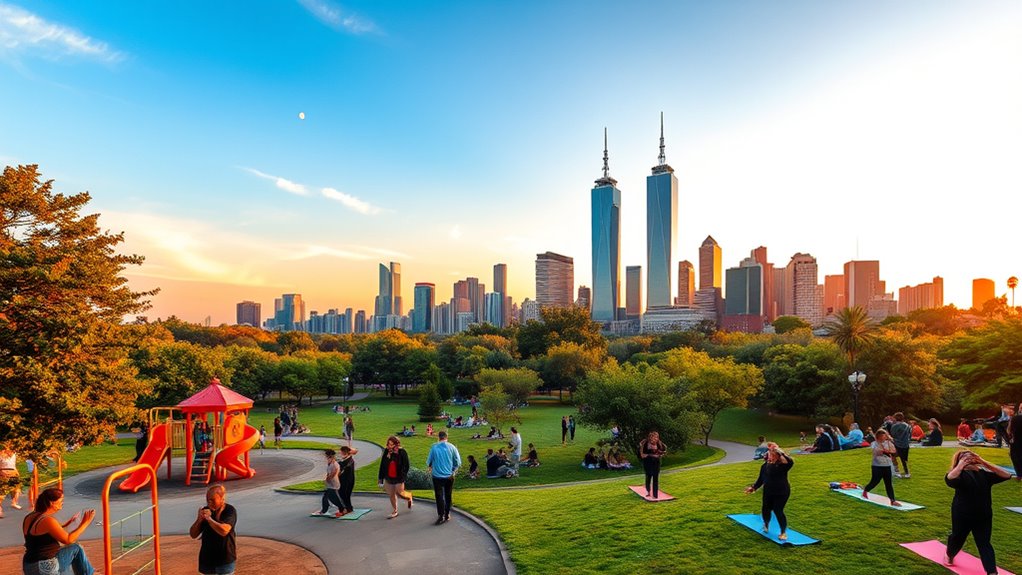The economics of leisure shows that your income, wages, and the costs of activities influence how much you value your free time. When wages are high, you might work more to earn extra, but lower leisure costs can encourage you to enjoy more activities. Your preferences also depend on age, culture, and social norms. To understand how you can maximize your free time and well-being, keep exploring these economic factors in more detail.
Key Takeaways
- Valuing free time involves understanding trade-offs between work income and leisure utility, influenced by wages and leisure costs.
- Economic models assess how changes in wages and leisure prices impact individuals’ allocation of time between work and leisure.
- Measuring leisure’s value at scale considers opportunity costs and societal benefits like well-being and productivity.
- Demographic and cultural factors shape how societies prioritize and invest in leisure activities, affecting overall leisure valuation.
- Policy approaches can enhance leisure’s value by promoting work-life balance and expanding accessible recreational opportunities.

Have you ever wondered how economic factors influence the way we choose to spend our free time? The answer lies in understanding the delicate balance between work and leisure, which is shaped by wages, recreation costs, and individual preferences. When wages are high, you might find yourself working more to earn that extra income, but when leisure becomes cheaper and more accessible, you’re more likely to indulge in activities that enhance your free time. This balancing act is central to the economics of leisure, where you constantly weigh the benefits of earning versus relaxing, influenced by the costs associated with recreation and the opportunity costs of time spent working.
Economic factors like wages and recreation costs shape our leisure choices and the balance between work and relaxation.
The neoclassical theory of leisure plays a key role in explaining this behavior. It assumes you’re a rational decision-maker who seeks to maximize utility—your satisfaction—from both work and leisure. According to this model, you’ll adjust your work hours based on changes in wages and leisure prices to reach market equilibrium. For example, if leisure activities become more affordable or more enjoyable, you might choose to work fewer hours because the opportunity cost of leisure decreases. Conversely, if wages rise considerably, you might work longer hours to earn more, even if it means sacrificing leisure time. This framework helps us understand broader trends, such as the historical decline in work hours in many countries and the simultaneous rise in leisure time.
Demographics also shape your leisure choices. Different age groups, genders, and socioeconomic backgrounds influence how much time and money you allocate to leisure. Younger populations might spend more on experiences like travel or concerts, while older groups might prioritize different types of recreation. As disposable income increases—thanks to economic growth—you’re more likely to spend on leisure activities, fueling the expansion of the leisure economy. Additionally, cultural beliefs and societal norms can significantly influence individual preferences for leisure and recreation. Today, digital platforms and social media further amplify this trend by making leisure options more accessible and engaging, encouraging you to spend more on experiences rather than material goods.
Over time, the landscape of leisure has shifted dramatically. Work hours, especially in OECD countries, have decreased, giving you more free time. The cost of recreation has fallen, making leisure more affordable for many. Meanwhile, the rise of experiential consumption has created new markets and investment opportunities, transforming how you pursue leisure. Although the neoclassical model provides a useful starting point, critics argue it oversimplifies consumer choices, overlooking social and environmental factors that also influence how you value and engage in free time. Policies promoting work-life balance can help you better enjoy your leisure, ultimately benefiting both individuals and the broader economy.
Frequently Asked Questions
How Does Leisure Impact Overall Economic Productivity?
You might wonder how leisure affects overall economic productivity. It’s a balancing act—you benefit from some leisure, which can boost your well-being and even work performance, but too much leisure reduces work hours and output. Ideal leisure hours, around 5,813 annually, help maintain productivity. Factors like education and capital investments are more influential for economic growth, but your leisure choices still play a key role in shaping productivity levels.
What Role Does Technology Play in Leisure Valuation?
Imagine a world where leisure becomes more than just downtime. Technology plays a pivotal role in this shift, transforming how you value your free time. It enhances experiences through smart tools, personalizes wellness, and creates new ways to engage. By doing so, technology shifts resources and attention, making leisure more impactful economically. This evolution influences how you perceive and utilize your free time, ultimately shaping societal and economic outcomes.
How Do Cultural Differences Influence Leisure Preferences?
You see that cultural differences shape your leisure preferences by influencing what activities you enjoy and how you spend your free time. In some cultures, socializing and sports are key, while others favor sedentary pursuits like reading or dining out. These norms guide your choices, reflecting societal values. Globalization also introduces new options, but your cultural background still plays a essential role in determining how you relax and prioritize leisure.
Can Leisure Time Be Quantified for Policy Decisions?
Imagine a time before smartphones, when leisure was simpler; now, you wonder if leisure time can be measured for policies. You can quantify leisure through surveys, scales, and economic valuation methods, translating time into monetary values. This helps policymakers track trends, address inequalities, and allocate resources effectively. While challenges like subjective bias exist, these measures enable informed decisions to enhance societal well-being and optimize leisure opportunities for everyone.
How Does Leisure Affect Income Inequality?
You might wonder how leisure impacts income inequality, and it does in significant ways. Higher-income people typically have less leisure but may value it more, while lower-income groups often enjoy more leisure time, which can reduce perceived inequality. Including leisure in inequality measures highlights these differences, showing that leisure can serve as a form of social ‘compensation,’ but it’s complex, as the quality and enjoyment of leisure vary across income groups.
Conclusion
As you step back and imagine your free time as a vast, open field, you realize its true worth isn’t just in moments of rest but in the endless possibilities it holds. Every minute you cherish adds richness to your life’s landscape. By valuing leisure, you’re investing in your well-being and future. So, embrace those quiet hours—they’re the hidden treasures that shape your happiness and fill your world with vibrant, lasting meaning.









